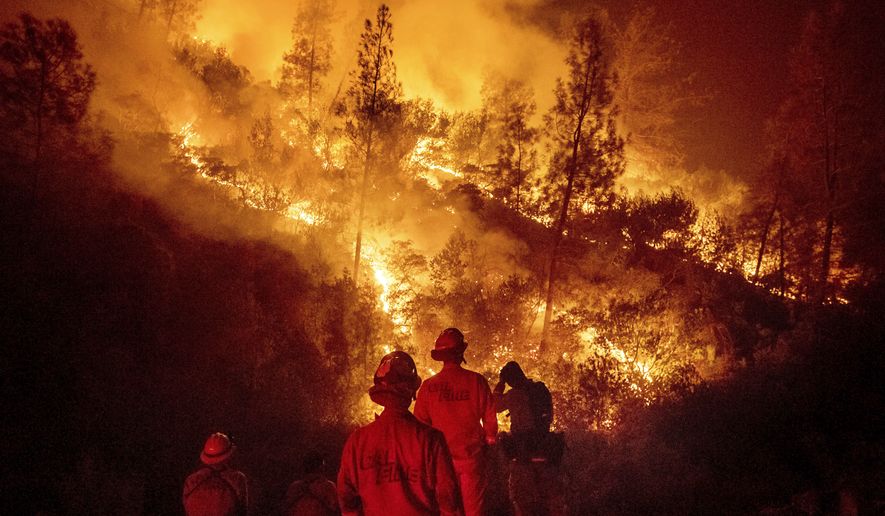After a disastrous wildfire season, California Gov. Jerry Brown is taking a page from Interior Secretary Ryan Zinke’s playbook by pushing legislation to clear the way for more logging in the state’s fire-prone forests.
Mr. Brown has backed an 11th-hour push to create exemptions in California’s notoriously tough environmental regulations, allowing small landowners to cut down larger-diameter trees, build temporary access roads in the woods, and bypass red tape in securing state approval of thinning projects.
The move to encourage more active forest management comes as part of Senate Bill 901, an expansive wildfire-prevention proposal slated for Assembly and Senate votes Friday evening, hours before the legislative session adjourns.
Rich Gordon, president of the California Forestry Association, a timber industry group, said the bill would be “really beneficial to forest health in California.”
“The science has become pretty clear here in California. Our forests are overgrown,” said Mr. Gordon. “In California, when the Europeans arrived, we had about 40 trees to an acre. We now have hundreds of trees to an acre. When you have fewer trees per acre, those trees survive fire, they survive drought.”
California has endured two catastrophic wildfire seasons in a row as flames rip through the state’s dense, beetle-damaged forests, notching a record in December with 129 million dead trees, the Forest Service reported.
Even so, environmentalists are split. Some green groups dropped their opposition after the bill was amended to address their concerns Tuesday in conference committee, but not the Sierra Club, which argued that the measure is still too aggressive.
“[S]tate policy and resources should be focused on fire-hardening homes and communities and appropriately treating the areas in and adjacent to communities based on the nature of the surrounding wildlands flora,” said Sierra Club California Director Kathryn Phillips in a letter Wednesday.
“We also strongly believe that opening new, unregulated logging in remote areas, as this bill will do, will neither protect communities from fire nor improve forest health and resilience. In fact, it may do the opposite,” Ms. Phillips said in the letter to Democratic state Sen. Bill Dodd.
The bill, which would provide $200 million for five years for thinning projects, would allow small landowners to cut trees up to 30 and 32 inches in diameter, depending on the location, without being required to file a timber-harvest plan.
That’s smaller than the bill’s original proposal of 36 inches but larger than the current state limit of 26 inches.
Kim Delfino, California program director of Defenders of Wildlife, said her group dropped its opposition in response to the revisions.
“They made the changes that we asked for, so we’re good,” said Ms. Delfino.
She said the legislation includes requirements for landowners to keep the six largest trees per acre and maintain canopy covers.
“While we’re nervous about expanding the diameter size, the understanding is that some of these protective measures will hopefully do what we want it to do and they’ll be able to roll out more vegetation management and fuel reduction projects in the state, which we’re very supportive of them doing,” said Ms. Delfino.
The logging provisions come as part of an expansion legislative measure that would also limit the liability of utility companies for starting wildfires, another hotly debated element.
The standoff over logging comes with the timber industry in California all but decimated in the wake of federal and state regulations aimed at protecting the environment and species such as the Northern spotted owl.
From 1981 to 2016, the California logging business plummeted by 82 percent. Only 30 sawmills remain, all of them privately owned and many of them run by families, not publicly traded corporations, said Mr. Gordon.
Mr. Zinke has blamed “environmental terrorist groups” for creating the conditions that have allowed wildfires to flourish. He spent the summer visiting fire sites and calling for more active forest management, tangling with environmentalists who attribute the problem to climate change.
Last year, destructive blazes blackened 1.38 million acres in California, while this year’s blazes have so far charred 1.25 million acres, led by the Mendocino Complex Fire, the largest in state history, which is 94 percent contained after burning 459,102 acres, according to the National Interagency Fire Center.
Does their stance on the bill mean environmentalists have warmed to Mr. Zinke’s position? Not necessarily.
“I wouldn’t say that — no. I would say that everyone agrees that we need to be managing forests so that they are more resilient,” said Ms. Delfino. “The devil is in the details.”
• Valerie Richardson can be reached at vrichardson@washingtontimes.com.




Please read our comment policy before commenting.